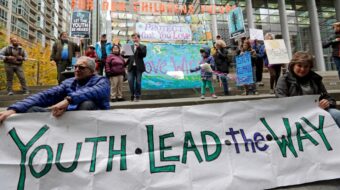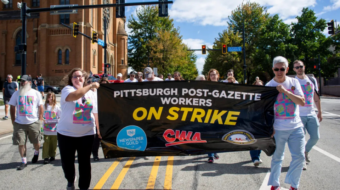Workers’ Correspondence
Transport Workers Union Local 100’s 38,000 members, employees of New York City’s Metropolitan Transportation Authority, voted in union elections on Dec. 10. The overall results represent a vote of confidence for the local’s reform leadership.
The reform slate, led by President Roger Toussaint, a track worker, Financial Secretary Ed Watt, a bus driver, and Recording Secretary Darlyne Lawson, a station agent, won the election with about 60 percent of the vote, maintaining a two-thirds majority on the Executive Board.
Reform candidates swept all offices in the Maintenance of Way Department, defeating the incumbent old guard leadership in the Structure Division, and swept all offices in Rapid Transit Operations. In Buses, the Toussaint slate swept the Maintenance Division of the Manhattan and Bronx Surface Transit Operating Authority (MABSTOA), and did well in MABSTOA Division II. In the Transit Authority (TA) Surface Division, Toussaint slate candidates won most E-Board positions and vice chair slots, as well as the recording secretary and executive board slots. A divisional slate not associated with either of the two major slates won in TA Surface Maintenance. In the Stations Department, candidates running on the “Toussaint Unity” slate captured most divisional offices and E-Board seats by convincing margins.
In MABSTOA Division I, however, anti-reform “old guard” elements won. These candidates ran on the “Members 1st” slate, a marriage of convenience between a pseudo-“left” splinter of the original “New Directions” reform movement and “old guard” right-wingers tied to TWU International President Sonny Hall.
The pseudo-“left”: Obstacle to reform
Making a real difference for workers at the workplace is the most difficult task faced by a reform leadership. The MTA has been on the offensive, resisting contract implementation and trampling on workers rights. While the Toussaint leadership has been fighting against these actions, the Members 1st slate opportunistically used them – blaming the actions of the MTA on the very leadership that was fighting against them. Such a combination of the pseudo-“left,” the “old guard,” and the employer, is tough to overcome. The MTA and certain elements in the local and international leadership needed a mask to hide behind, which the pseudo-“left” supplied. This allowed the “old guard” to eke out narrow victories for certain departmental and divisional positions.
A recent article in The Chief, a newspaper widely-read by NYC workers, focused on some of these internal issues, insinuating that the union’s membership is divided. In fact, the membership is not divided, but segments of the membership were misinformed by the anti reform Members 1st slate.
Members voted their experience
A close analysis of the vote makes it clear that members voted based on immediate, workplace issues. Going forward, the local must step up its role in protecting workers’ rights at the point of production and must build on gains already made. In three years, the Toussaint leadership has delivered an excellent contract that guarantees health benefits and provides programs for day care, upgraded training and job safety. It has mounted mass mobilizations, restored the union’s clout in electoral politics and the labor movement, and has initiated a lively, informative and militant Local 100 newspaper. The task for the future is to accelerate the fight to protect workers rights and step up outreach and educational efforts.
Toussaint message to membership
On Dec. 13, a few days after the vote count, President Toussaint addressed a mass assembly of members, emphasizing the need to step up the fight at the workplace and the need for unity. He laid out a five-year plan, including strategic ideas for the 2004 U.S. presidential election and the 2005 contract negotiations. Unsaid, but critical to Local 100, is TWU’s national convention coming in October 2005.
– Gary Bono (gamoo@compuserve.com).









